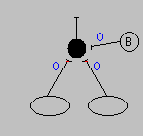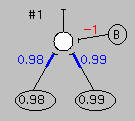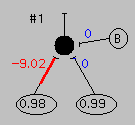Remote Ready Biology Learning Activities has 50 remote-ready activities, which work for either your classroom or remote teaching.
Serendip is an independent site partnering with faculty at multiple colleges and universities around the world. Happy exploring!
Let's see if we can come up with something simple that can learn to tell the difference between ... oh, let's see ... something simple ... how about an elephant and a rabbit?
 We'll start with a simple brain (or a simple computer) which consists of four simple elements connected as shown to the left. The bottom two ovals we'll call "input" units and the filled circle we'll call an "output" unit. They are actually all we really need (for present purposes), but things will work a little better if we have a fourth "bias" element, the circle with the B in it. The input elements collect information from the outside world and send it to the output element which uses it (and information from the bias unit) to determine what it says (hopefully something useful) about the outside world.
We'll start with a simple brain (or a simple computer) which consists of four simple elements connected as shown to the left. The bottom two ovals we'll call "input" units and the filled circle we'll call an "output" unit. They are actually all we really need (for present purposes), but things will work a little better if we have a fourth "bias" element, the circle with the B in it. The input elements collect information from the outside world and send it to the output element which uses it (and information from the bias unit) to determine what it says (hopefully something useful) about the outside world.
 Let's further imagine that all elements represent information in turns of a level of activity, a number which can have any value between -1 and 1 (except for the bias unit, which always has a value of 1). A value of 1 in the left input element, for example, might indicate very tall, and a value of -1, might indicate very short (with intermediate numbers corresponding to intermediate heights). Similarly, a value of 1 in the right input element could represent very wide, and a value of -1 something much thinner (with intermediate numbers corresponding to intermediate widths). So an elephant would cause a value of (more or less) 1 in the left input element and a value of (more or less) 1 in the right input element as well (as shown in the picture to the right). A rabbit, on the other hand, would cause values of -1 in both elements (as shown to the left below).
Let's further imagine that all elements represent information in turns of a level of activity, a number which can have any value between -1 and 1 (except for the bias unit, which always has a value of 1). A value of 1 in the left input element, for example, might indicate very tall, and a value of -1, might indicate very short (with intermediate numbers corresponding to intermediate heights). Similarly, a value of 1 in the right input element could represent very wide, and a value of -1 something much thinner (with intermediate numbers corresponding to intermediate widths). So an elephant would cause a value of (more or less) 1 in the left input element and a value of (more or less) 1 in the right input element as well (as shown in the picture to the right). A rabbit, on the other hand, would cause values of -1 in both elements (as shown to the left below).
 Now we need to know how numbers in the input (and bias) elements influence numbers in the output element, and we need to know what those in turn mean. Let's have the output element listen to both input elements (as well as to the bias unit), but pay attention to them by some amount which can be different for each. This is a lot like one neuron in a brain receiving signals from other neurons across different synapses which have different effectivenesses, and so we'll use the term "synaptic weight" to express how much attention the output neuron pays to each input neuron (as well as to the bias neuron). This gives us three more numbers (the colored ones in the figure to the left, as well as those above), which can also be either positive or negative (colored lines associated with the input neurons give a graphical impression of the synaptic weight values of the input units). If we now take each activity level, multiply it by the appropriate synaptic weight, and add them up, we get an activity level for the output element. One final step. We'll use an "activation function" to get from the activity level to the actual output: if the activity level is greater than or equal to zero, we'll make the output 1 (white in the figures). If it is less than zero, we'll make the output -1 (black in the figures). And, last of all, we'll agree that 1 means an elephant, while -1 means a rabbit.
Now we need to know how numbers in the input (and bias) elements influence numbers in the output element, and we need to know what those in turn mean. Let's have the output element listen to both input elements (as well as to the bias unit), but pay attention to them by some amount which can be different for each. This is a lot like one neuron in a brain receiving signals from other neurons across different synapses which have different effectivenesses, and so we'll use the term "synaptic weight" to express how much attention the output neuron pays to each input neuron (as well as to the bias neuron). This gives us three more numbers (the colored ones in the figure to the left, as well as those above), which can also be either positive or negative (colored lines associated with the input neurons give a graphical impression of the synaptic weight values of the input units). If we now take each activity level, multiply it by the appropriate synaptic weight, and add them up, we get an activity level for the output element. One final step. We'll use an "activation function" to get from the activity level to the actual output: if the activity level is greater than or equal to zero, we'll make the output 1 (white in the figures). If it is less than zero, we'll make the output -1 (black in the figures). And, last of all, we'll agree that 1 means an elephant, while -1 means a rabbit.
 There exists at least one interconnected set of elements which will correctly identify both elephants (as shown to the right above) and rabbits (to the left above, the same network with different input values). And it is the particular set of synaptic weights present in such networks which gives the network this ability. With different weights, elephants would be identified as rabbits (as shown to right), and/or rabbits as elephants. The obvious question then is how do the weights get to their needed values? Does someone have to set them correctly, or can a network find them itself?
There exists at least one interconnected set of elements which will correctly identify both elephants (as shown to the right above) and rabbits (to the left above, the same network with different input values). And it is the particular set of synaptic weights present in such networks which gives the network this ability. With different weights, elephants would be identified as rabbits (as shown to right), and/or rabbits as elephants. The obvious question then is how do the weights get to their needed values? Does someone have to set them correctly, or can a network find them itself?
Can I go back to the beginning instead, please?
| Forum
| Complexity | Serendip Home |